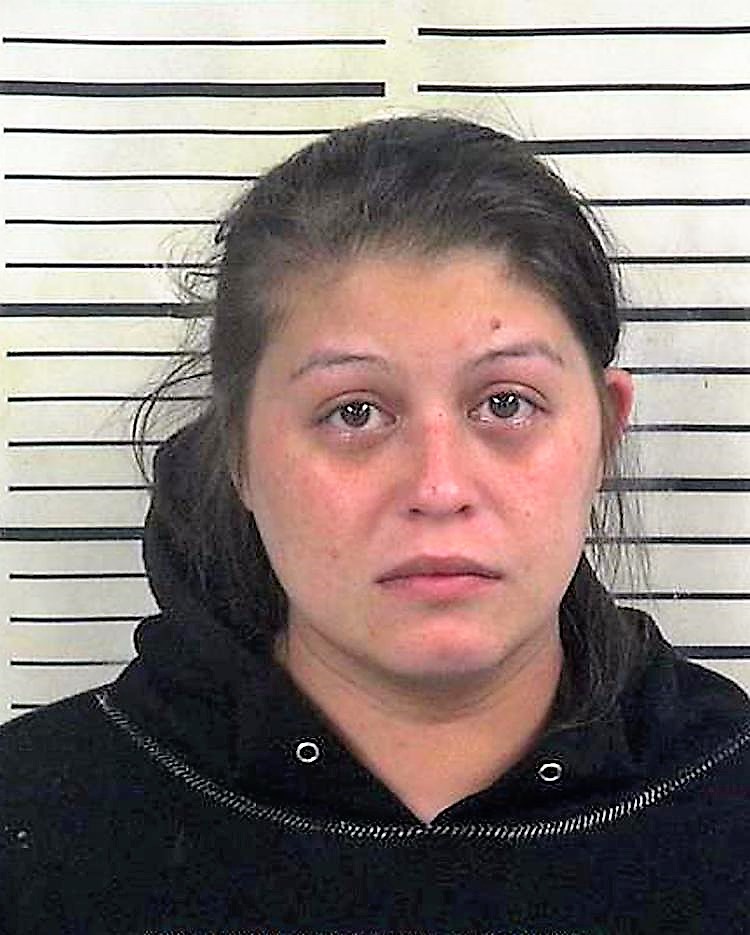Crystal Lynn Bulliner (original mug shot from the Cullman County Detention Center)
CULLMAN – Late Friday evening, Cullman resident Crystal Lynn Bulliner and her defense attorney Melvin Hasting won a decisive victory when a jury returned after three hours of deliberation to acquit Bulliner on three separate charges stemming from the 2014 drug overdose death of Vincent Mitchell McGough.
The Tribune, the only local media in attendance at the trial, broke the news minutes after the verdict.
The landmark case was Cullman County’s first known test of an interpretation of the Alabama Criminal Code’s definition of murder that would allow drug dealers to be charged with felony murder or reckless murder if a drug they supply to a customer leads to that customer’s death. Several states and jurisdictions across the country have used similar interpretations to offer forceful responses to the increasing number of drug overdose deaths, especially from heroin and fentanyl.
Under Alabama Code 13A-6-2a (3), a person can be charged with felony murder if he or she commits any “felony clearly dangerous to human life and, in the course of and in furtherance of the crime that he or she is committing or attempting to commit, or in immediate flight therefrom, he or she, or another participant if there be any, causes the death of any person.” In this case, the felony was the sale of illegal drugs.
Under Alabama Code 13A-6-2a (2), a person can be charged with reckless murder if, “Under circumstances manifesting extreme indifference to human life, he or she recklessly engages in conduct which creates a grave risk of death to a person other than himself or herself, and thereby causes the death of another person.” In this case, the conduct was supplying the drug to an addicted person likely to use it in a dangerous manner.
Bulliner was initially arrested for manslaughter, but in 2015 a grand jury returned three indictments including felony murder and reckless murder, on any one of which she could be convicted.
Timeline of events
Three young men were with McGough on the day of his death, as well as the night before: Asa Belue, Grey Slatton and Jesse Alldredge. All three testified at the trial, and their accounts agreed on many points and painted the following picture of events on Aug. 10-11, 2014.
- Late in the evening of Aug. 10, McGough, Belue, Slatton, Alldredge and others went to East Side Park in Cullman to smoke marijuana. The four then went to Alldredge’s home to play video games, before separating early in the morning. Slatton and Belue left for Belue’s house, while McGough and Alldredge stayed.
- Around lunchtime on Aug. 11, McGough made a deal via text message to go and buy two fentanyl patches in the parking lot of the U.S. Highway 278 Shell station in Cullman. Phone records indicated that the text conversation took place between McGough’s number and that of Bulliner. Despite having his own vehicle at Alldredge’s house, McGough offered to buy Alldredge a drink or snack and let him have half of one of the patches to be paid for later, if he would drive McGough to the station.
- McGough met someone at the station, whom Alldredge later identified as Bulliner, and came back to the vehicle with two fentanyl patches. Alldredge did not participate in the deal, waiting in the vehicle and observing from a short distance away.
- Upon returning to Alldredge’s house, McGough cut one of the patches open, scraped out the gel inside, and chewed it to extract the fentanyl. He cut the other patch in half, giving half to Alldredge. Alldredge ingested the contents of that half patch the same way. The remaining half patch was left in Alldredge’s bedroom for Belue, who had earlier agreed to buy it from McGough.
- A short time later, Alldredge became concerned, noticing that McGough had become “messed up,” but he seemed to get a little better. Alldredge left to go mow grass at a relative’s house, but texted Belue and Slatton to come watch over McGough while he was gone.
- Slatton arrived first and found McGough asleep and supposedly snoring in a chair in Alldredge’s bedroom. He moved the sleeping man to the bed, then sat down to play a video game.
- A few minutes later, Belue arrived and noticed that McGough was turning blue. Alldredge was called to come back to the house, and Slatton attempted to perform CPR. After Alldredge arrived, the three decided that one would drive McGough to Cullman Regional in McGough’s truck while the other two came in a separate vehicle.
- At the emergency room, the three got someone to remove McGough from his truck and take him inside. They stayed long enough to give a supervisor a brief description of what had happened, then left. McGough was pronounced dead a short time later.
No autopsy was done, but blood drawn from the body later on Aug. 11 by then then-Coroner Steve Rogers was screened by the Alabama Department of Forensic Sciences and ADFS contractor NMS Laboratories. The tests indicated that McGough’s blood contained alprazolam (Xanax), lorazepam (Ativan), and traces of nordiazepam, a by-product of the metabolism of diazepam (Valium). All three are anti-anxiety medications and mild sedatives, and the levels of each in McGough’s blood were very low. The fentanyl level, though, appeared to be four times the safe dosage and double the average level in overdose victims. The coroner’s official cause of death was listed as multiple drug toxicity, but fentanyl was the only one of the drugs at a dangerous level.
Bulliner, a former coworker of McGough’s, was identified as the person who sold him the fentanyl; a review of Verizon text message records from the day of the incident, obtained by court order, appeared to point to a planned deal between the two for two transdermal fentanyl patches a short time before the overdose.
Trial
On Monday, July 30, Cullman County Deputy District Attorney John Bryant, Assistant D.A. Jeremy Kline and defense attorney Melvin Hasting selected a jury, then moved to opening statements before Circuit Judge Gregory Nicholas. Bryant read the indictment statement, explained the definitions of manslaughter, felony murder and reckless murder and gave a short summary of what authorities claim happened in the hours leading up to McGough’s death. Hasting warned the jury that the next day or two would be full of technical testimony from people who are called experts. He also set forth the claim that McGough died of multiple drug toxicity, and not just the fentanyl he allegedly acquired from Bulliner. The day closed with testimony from members of McGough’s family about happy teen years and his struggles with pain medications after sports injuries in high school.
On day two, jurors heard from Cullman Police Capt. Becky Boyd, who investigated the case and watched videos of an interview with Bulliner conducted by Boyd and then investigator (now Assistant Police Chief) Craig Montgomery. A former coworker of both Bulliner and McGough testified to having bought fentanyl from Bulliner. Belue offered his description of what happened that day and the night before. A representative of Verizon gave initial testimony about phone and text records, then the jury heard about McGough’s blood toxicology from Rogers, NMS Labs drug analyst Rachel Christine Riley and ADFS Toxicology Chief Dr. Curt Harper. Hasting’s cross-examinations noted inconsistencies between two versions of the text message records, challenged the chain of custody of McGough’s blood sample, and repeatedly pointed out the presence of multiple drugs in his system aside from fentanyl.
On Wednesday, Belue returned to the stand, not having been cross-examined on Tuesday in order make time for the toxicology experts. He faced extensive questioning about his own history of drug use and about events on the day of McGough’s death. Hasting asked him if the three had made up a cover story, and he denied that they had. Then Alldredge took the stand to offer his own testimony on the events of that day, including an eyewitness account of McGough’s purchase of the fentanyl, as well as a second denial of a cover story during cross-examination. Police investigator, Lt. Jody Martin finished the day by describing details appearing in photos taken of McGough’s body at Cullman Regional. Hasting pointed out marks around both of McGough’s ankles that appeared to be consistent with needle tracks.
A drug users’ network in Cullman
During the day on Wednesday, Holly Connor, an intelligence analyst with the Regional Organized Crime Information Center, gave detailed testimony about text message records between McGough’s phone and others, painting a picture of a circle of friends and associates in the Cullman area (including the three friends and others) who were actively networking and regularly shopping for numerous drugs, including (from the text records):
- “Bud” – marijuana
- “Loud” – high-grade marijuana
- “Patches” and “stickers” – fentanyl
- “Roxies” – roxicodone
- “Footballs” and “bars” – Xanax
- “Tabs” – Lortab
On Thursday, the prosecution called Slatton to the stand to present his account of the events of Aug. 10-11. During cross-examination, Slatton admitted that other written statements were given earlier than those presented in court. Hasting also pointed out in Slatton’s statement where he claimed a cover story was developed, contradicting the claims of the other two friends. Hasting then questioned Slatton about the plan to clean up any drug paraphernalia from the friends’ respective homes after arriving back from the hospital, which Slatton confirmed.
The state then called DEA Supervisory Special Agent Sean Stevenson, who has worked with staff from the Cullman County Sheriff’s Office. He described the opioid epidemic in the U.S. and talked about signs of fentanyl overdose. When questioned, he said that it can take hours for someone to die from overdosing on fentanyl. Stevenson looked at the coroner’s photos of McGough’s feet, and confirmed to Hasting that the marks on his ankles were consistent with needle tracks.
After lunch recess on Thursday, Hasting reported to the judge that he had seen a juror chatting with one of the witnesses on the way to lunch. That juror was dismissed, leaving a pool of 13 (twelve plus one alternate)
Early on Thursday afternoon, the defense began presenting its case. The prosecution had not rested, but Hasting had two witnesses who could only testify that afternoon. He called Kelly Buckner, the Cullman Regional supervisor who talked to the three friends, who confirmed that McGough had no pulse when brought into the ER. Hasting then questioned Gary Lee Edwards, the Cullman Regional employee who brought McGough’s body out of the truck into the ER.
After the morning’s talk about missing early witness statements from the three friends, Hasting then asked Judge Nicholas to dismiss the case. After a short bit of wrangling from both sides, Nicholas recessed the case for the day three hours earlier than previous days, so both the defense and prosecution could review those documents before proceeding.
On Friday morning, the prosecution took over again with Montgomery, who had assisted Boyd in the investigation, on the stand. Montgomery testified about Alldredge, who had bought drugs from Bulliner before, being able to identify her in a lineup and being able to identify her apartment when Montgomery drove him there. The jury was shown the video of a subsequent interview of Bulliner by Montgomery and Boyd, in which Bulliner admitted to being at the Shell station but claimed that she only sold McGough a cigarette, and that the "stickers" mentioned in the texts were really just stickers. She also claimed that McGough got the patches from a man named “Bucky” or “Bud” in West Point, who ordered the prescription patches online. Hasting also called Boyd back to the stand for more questions about text records that included references to syringes by McGough, and a review of the possible needle tracks in the photos of McGough’s body. He also pointed out that the police did not get a warrant to obtain security footage from cameras at the Shell station that could have contained important visual evidence.
During the day, the Judge Nicholas removed felony murder, the most serious charge, from the list of charges and added criminally negligent homicide, a class A misdemeanor, in its place. Hasting continued to challenge the chain of custody of the blood sample.
During closing arguments Friday afternoon, Kline showed the jury a timeline of events that led up to McGough’s death. He went over texts and interviews and pointed out inconsistencies in Bulliner’s story through the interview process. He established the grounds for the manslaughter charge, and highlighted the ADFS testimony that, even with the other drugs in his system, McGough’s death was caused by the Fentanyl.
Hasting’s closing argument emphasized that Bulliner was not on trial for selling drugs, but for allegedly murdering McGough. He accused state witnesses of giving “half-truths and half evidence,” and accused the state of focusing so tightly on Bulliner that it was willing to overlook the actions of the three friends. Hasting reiterated that the coroner, after consulting with ADFS, listing the cause of death as multiple drug toxicity.
Prosecutor Bryant got the last word, talking about the number of times texts indicated McGough and Bulliner communicating about drugs, Bulliner’s fentanyl deals with other buyers, how Bulliner never answered some of the questions asked by police, and how high the fentanyl level was in McGough’s system.
After detailed instructions, the jury was sent into deliberation just before 6 p.m. About 20 minutes later, jurors requested more detailed definitions of the three charges. At 8:25, word went out that a verdict had been reached, and the jury presented the verdict 10 minutes later. The jury foreperson was in tears as she read the three verdict forms aloud. Other than that, the courtroom was silent until the foreperson read the last verdict. At that, Bulliner gasped loudly and burst into tears.
Prosecutors and police left the room in silence after the verdict, as Bulliner first embraced her attorney, then her family. Deputies escorted her and her family out, along with Hasting.
Outside, Hasting told The Tribune, “We’re satisfied with the verdict, on behalf of Crystal Bulliner. And it’s emotional, it’s tough. Unfortunately, it doesn’t change the fact that a young man lost his life . . . A lot of people made a lot of bad decisions. And I’m talking about all the way through: I think that involves the investigation of the case, I think that involves the beginning of the case–how he got in that situation–the investigation of the case. There’s just a lot of stuff that happened. And I think the jury seen that, and they entered a verdict.
“Well, of course we enjoy it, and we respect it.”
Copyright 2018 Humble Roots, LLC. All Rights Reserved.



























